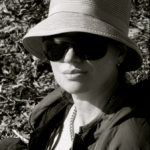Totally confused – Attaching the Facing
-
16 years ago LINK
Strawberree @Strawberree
This is the step I am confused on as well. In the illustration, when attaching the lining to the bodice of the Puppet Show Tunic, where do I sew the lining? It appears as if the button area is folded back, and I am sewing through the lining, the bodice, and the button area. But this can’t be right, because then the button area is enclosed between the lining and the bodice. I would love a photo of how to attach the lining to the bodice!
16 years ago LINKOk, let’s see if this image helps explain what’s going on with the placket and facing for many of our patterns. You can see that the outside fabric wraps around to the inside to form the placket, and the facing is sewn to the edge of the placket. This is why the facing is shorter than the outside of the garment:

This particular image is from a Puppet Show Tunic, but the placket/facing shows up well because the facing is a different fabric than the outside of the garment. Does this help to clarify?
16 years ago LINKAnd here are a few images specifically of the Birthday Party Dress during construction:
In this first image, the placket has been completely unfolded, and the back edges of the dress and the facing are sewn together with a 1/2″ seam allowance:

Then the dress is re-folded at the notches for the placket fold, with right sides together:

And here is the facing, sewn to the top edges of the dress with the placket folded back:

Keep in mind that both the Puppet Show Tunic and the Birthday Party Dress are rated as three of four scissors in difficulty and are best sewn by more experienced seamstresses. If you’re relatively new to sewing, this construction may be a bit difficult to understand at first (not difficult to sew, but difficult to understand). But if you can see it in person I think it will become very clear and you’ll be thrilled at the result.
If these photos and explanations aren’t doing the trick for you and you still don’t understand, you might want to see if you can sit with someone you know who is an experienced seamstress and who can help clarify this method for you. If you don’t have a friend in the area who can help, check in at your local independent fabric shop. Independents provide great resources to their communities, and you’re almost sure to be able to get some assistance with this issue there.
16 years ago LINKrevannie @revannie
Thsnk you for the instructions and pictures. For some reason my back placket ended getting folded twice after I attached the facing, which will make the dresser smaller, of course. When I make it again I’ll pay close attention to the pictures, markings, and cutting. Annie
16 years ago LINKtonyadel @tonyadel
Thank you so much for the photos and the instructions above. I just finished the birthday party dress, and I don’t think I would have been able to figure it out without these instructions. Now I feel more confident about my sewing abilities overall. I am very excited about how it looks. I just need some buttons.
16 years ago LINKNarelle @Narelle
Liesel thank you for posting the photos. I came in here specifically to see if there were any hints on how to attach the facing, and am so glad I did.
I attempted my first Birthday Party dress yesterday and was also completly confused when I got to the facing. Haha I stood confused for a couple of hours and then attached the facing in my own, very unprofessional way! Now seeing the photo, I think I was folding it the wrong way. The photos explains it perfectly 🙂 My 2nd niece to get her dress will have it constructed perfectly now 🙂
15 years ago LINKellen81 @ellen81
So, I thought that I had this, but I cannot figure it out around the button placket. It keeps ending up with the facing on the outside of the placket and not under it like it is supposed to be. The step where I seem to be getting lost is the step after you first sew the sides of the facing to the very back of the dress. How do I line up the sides in the next step so that the facing is in the right place?
I feel like there is something really easy that I am missing….
Thanks,
Ellen
15 years ago LINKToyota888 @Toyota888
You will see from the rest of this thread a lot of people have trouble with this bit!! Make sure you have unfolded the main dress fabric (the placket) all the way back to the raw edge and sew together with the raw facing edge and the raw dress edge aligned. It is kind of counter intuitive because you have just been instructed to fold it all up and then you have to undo it all! I hope this is the problem otherwise I have no idea!
14 years ago LINK nancy
@dollfancier
nancy
@dollfancier
Once again, this thread has come in handy! I LOVE having the piccies to guide the way.
Thank you, everyone!
xo, Nancy
13 years ago LINK Sarvi
@Sarvi
Sarvi
@Sarvi
I’m bumping this thread rather than starting a new one, because of the photos posted above. If I want to add a sheer fabric at the bottom edge of the skirt, which will extend below it, so it looks like a double layer, how best would I do that? I was thinking at first of inserting my sheer fabric between the hem and the hem facing, where the pink area is the last photo above, but I can see that there would be a small area, where the placket is, that would have no sheer fabric. Seems like that might look rather weird. Any thoughts?
13 years ago LINK Nicole
@motherof5
Nicole
@motherof5
Do you mean this Sarvi?
Here is the link http://www.oliverands.com/blog/2009/03/easter-dress.html.
13 years ago LINK Sarvi
@Sarvi
Sarvi
@Sarvi
Exactly! Thank you, my hero!
11 years ago LINK cybele727
@cybele727
cybele727
@cybele727
Thank goodness for this forum. I am working on the birthday party and my exact question for hem facing was do you fold out the placket totally and match raw edges or do you leave the 1/2 ” folded. I admit I am confused when it says unfold the placket or such, because I never know does she mean COMPLETELY?? Or does she mean just that 1 1/4″ part. 🙂 I have my answer from this post.
Liesl, maybe when you do your instructions next time for a hem facing you can tweak them to say “fold out the placket completely and sew the raw edges together.”
Which I am now going to write directly on my own pattern. The mind isn’t what it used to be! 😉
10 years ago LINKCellisttoo @Cellisttoo
I am making a sneaky school uniform using the birthday party dress pattern and had some questions. First of all, I used bias tape to finish the bottom edge of the facing. Now that I am about to make the pleats I am wondering if you pleat the facing fabric as well as the outside? I am afraid that it is going to be lumpy with the bias tape. Second I am wondering if I should tack the bottom of the facing to the dress before making the pleats? FYI it is sewn out of a ravely gabardine. If so, would you use blind stitching to do this- just like the hem facing? Finally for the pleats, I marked the inside of the front panel- I think that I should have marked the outside, since the first step is to fold wrong sides together and stitch along the line I marked. Can someone verify & I will transfer my marks.
I really like this dress, and wish that I had cut two. I used a washable wool suiting fabric and it is sewing up really, really nicely. Was even able to do French seams on the inside to make it neat and durable for our grade schooler. After this one is done, back to the music box jumper for the third time.
10 years ago LINK Lightning McStitch
@LightningMcStitch
Lightning McStitch
@LightningMcStitch
@cellisttoo I’ve made one with a bias bound facing and it works fine. There’s a picture of the insides on this blog post if it helps: http://bartacksandsingletrack.blogspot.com.au/2014/03/first-birthdays.html?m=0
You’re right, both the dress and the facing get pleated together. I didn’t find the bias binding caused a problem but mine was a cotton lawn, so quite thin.
If your fabric is a bit tricky then basting the facing to the dress before making the pleats might help. Then the two will behave more as one.
I wouldn’t bother blind stitching the facing to the dress, but just do some basting stitches that you can remove once the pleats are made. Only necessary if you think your fabric is a bit shifty and evil. Otherwise just iron the pleats really well and it works fine.
You must be logged in to reply to this topic.
copyright
Unless otherwise credited, all work on this blog is © Liesl + Co., Inc, 2008-2025. You are welcome to link to this blog, but please ask permission before using any text or images.